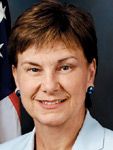FDA eyes sentinel network for postmarket safety
Now that we have electronic record technology, how should we set up a postmarketing surveillance system for drugs, biologicals, and medical devices?

The agency envisions that such a "sentinel network" will be established through several broad-based, public/private partnerships and will integrate existing and planned efforts to analyze and disseminate information to practitioners and patients at the point of care. The FDA said new information technology and private-sector interest in postmarket safety provide an opportunity to better integrate postmarketing surveillance.
FDA commissioner Andrew C. von Eschenbach, M.D., told attendees, "If we have the ability to extract these data, acquire them, assemble them, and analyze them, we, in fact, have an opportunity to rapidly and radically transform the evolution of knowledge-knowledge of what is happening with regard to disease and health in the human condition." He said such a system could be "one of the most profound contributions to the new era in health care."
Finally, calling for risk communication to be integrated into the work flow of clinical practice, Woodcock said the current system "is extremely fragmented and isn't working very well. We cannot just bombard physicians, pharmacists, and nurses with pieces of paper."
At the March meeting, staff from the FDA and other federal agencies heard presentations on a variety of information and research systems that might be part of, or models for, such a sentinel network. Within the pharmacy arena, Benjamin Bluml, R.Ph., VP of research for the American Pharmacists Association, described that group's Pharmacy Research Network, with its more than 200 sites that track patients, adverse events, compliance, and drug interactions. Under development for three years in conjunction with the company Applied Clinical Intelligence, the network's phase III and phase IV work has resulted in numerous adverse events targeted in the pharmacies and fed back to both the manufacturer and the reporting system, said Bluml.
Similarly, Donald Hackett, head of Community MTM Services, a medication therapy management initiative of the National Community Pharmacists Association, said his company is focused on, among other things, moving data not only from electronic health records and personal health records but also from a pharmacy clinical system, which he said the pharmacy on Main Street does not currently have. He indicated that reporting will be integrated into the system this summer and that the system may have integrated event reporting so the pharmacist does not have to go to a Web site to report.
Hugh Tilson, M.D., Dr.PH, chair of the national steering committee for the Centers for Education and Research on Therapeutics (CERTs), asserted those centers are perhaps "our next best key to unlock the riddle of sentinel systems." The 11 CERTs, sponsored by the Agency for Healthcare Research & Quality, in collaboration with the FDA, also receive funds for projects for HMO research and other sentinel networks.
Several speakers emphasized making physicians central to event reporting. Landen Bain, liaison to health care for the Clinical Data Interchange Standards Consortium, described that group's public domain initiative to allow clinicians to bring up an event-reporting form within an electronic health record and have the record automatically populate the form with appropriate data.
On the other hand, Jonathan Morris, M.D., president/CEO of ProSanos Corp., an analysis company, said that while the nation does need to get R.Ph.s and physicians more involved in data capture, "we are also sitting on volumes and a wealth of data that we are not leveraging today." ProSanos tools are being used today in Kaiser Permanente for signal detection and evaluation on about three million patients, he said.
How PBMs Impede Pharmacists’ Ability to Perform Clinical Services | APhA 2025
March 31st 2025Antonio Ciaccia, President of 3 Axis Advisors, led a discussion on pharmacy benefit manager reform and how the inability to pass legislation has led to increased financial hardships in community pharmacy.